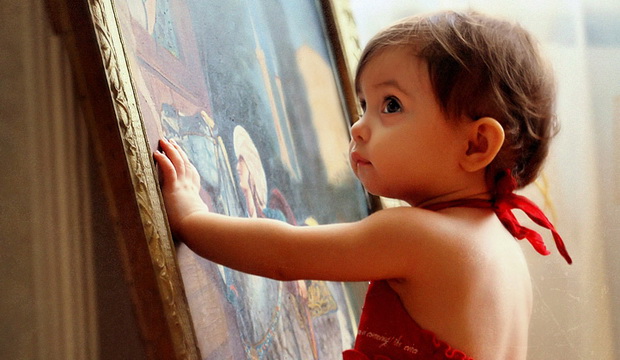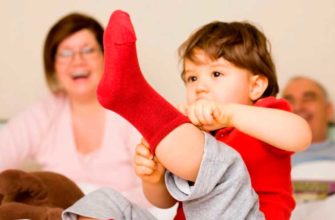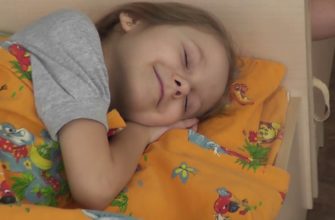When a small person is born, often all that he sees during the first years of his life (not counting the days in the hospital) is the walls of his home and a playground in the yard. These smells, light and colors will remain in his memory for life. Have you ever wondered how what he sees around him affects the development and worldview of a child?

Many probably heard: 85% of information about the world a person receives through his eyes and only 15% from other sources. In addition, scientists believe that the period of childhood is most sensitive to environmental influences: real or imagined. It turns out, it is extremely important that from a very early age the child sees the beauty around him, so that he learns to appreciate and love her from the cradle.
What does this affect?
When a baby grows up surrounded by beauty in all its diversity - from harmonious colors in the interior to a beautiful view from the window of his room, he, according to scientists, learns to creatively solve problems, find the relationships between different knowledge and phenomena in its solution, he develops a flexible mind .
Further more. According to the doctor of pedagogical sciences, corresponding member of the Russian Academy of Education Lyubov Savenkova, when a child begins to draw, sculpt, create, this develops his imagination space: the breadth of imagination, the breadth and variety of impressions, thoughts.
According to another scientist - A.V. Bakushinsky, the largest domestic theorist of aesthetic education, - children's creativity helps the child to perceive the surrounding reality in a new way, forms the ability to organize the environment, his world, and create a certain mood.
Many, after reading these lines, nod in agreement: “Yes, we do so!” I listened to classical music when I was pregnant. And now my children go to paint. " Of course, this is very important. But is this enough for the full development of the child? Do parents use all the opportunities to instill a sense of beauty in their children?
The harsh truth of life
In practice, studies show that everything is not so simple. Lyubov Savenkova, already known to you, tells in her article about an experiment conducted among students in grades 4–8 of a secondary school in Moscow.
Researchers decided to see if the children take part in the process of organizing the interior of the apartment, whether adults take into account their desires and needs. An important nuance: all the children lived in new homes, which means they had the opportunity to express their opinion when decorating the interior. After all, as a rule, each member of the family brings his understanding of comfort, convenience and beauty to a new apartment.
The children were offered to decorate their room or part of it as they see fit.Parents were asked to give their children complete freedom and not help with advice.
To complete the picture, the researchers also conducted a survey in schools near the homes of participants. The results of the survey looked encouraging: almost every child had his own room, almost 60% of the children were engaged in art classes. According to the survey participants, they actively participated in all matters of creating the interior of the rooms.
What actually turned out to be? When the researchers came to real apartments, they saw well-furnished, expensive interiors in which the child had no place. They all as one consisted of a large cabinet table with two cabinets by the window, a table lamp, a bookshelf, a card on one wall, a carpet on the other, a closet with clothes and utensils, a palace. Sometimes it was possible to meet an aquarium or a picture on the wall.
Wallpaper in these apartments did not differ in children's patterns, there were no special children's furniture, children's drawings on the walls. Even toys, at best, were on the top shelf of the cabinet. What can we say about the conditions for the child to sculpt, draw or paste applications without fear of breaking or dirtying something.
The conclusion about the participation of the child in the interior design was self-evident. Parents decided that for the development of creativity, it was enough for him to allocate his room and pay for the circle. Although, as scientists say, it is important that a child from an early age personally participate in the design of living space, creating an environment so that his needs are taken into account. Indeed, it is during this period of childhood that a taste for color is formed, color preferences develop. No less important is how not only the child’s own room looks, but also in what architectural environment it grows. The ideal environment for fostering a sense of beauty is classical architecture. So, the domestic researcher Mikhail Chernoushek in his work “Psychology of the Living Environment”, expressed the opinion that the environment includes, in addition to measurable physical and chemical quantities, a psychological characteristic. It is expressed in what kind of reviews, feelings the environment causes in us: accelerates or suppresses our actions.
Aged classical forms and facades of buildings invariably evoke positive emotions along with classical music or paintings. According to the architect Maxim Atayants, the author of the Sochi Olympic venues and the event city of Laikovo, the largest new classical-style city in the world, both the city and people need an aesthetic component and diversity of space. In faceless and groomed areas, the level of street crime is higher than in the historical center of the city, which, by definition, is aesthetically more attractive. A person’s behavior changes depending on the environment in which he is located. In a pleasant, well-groomed environment of any kind, unbridled looks out of place.
Where to start today
- Select a place in the apartment where the child will be able to conduct experiments, play, break and build, work with paints, clay, paper, build structures from all kinds of material without fear.
It is important that this place is not in the pantry or in a dark corner - for creativity you need as much natural light as possible. It is noted that in a bright room in children, creativity and a desire to work are significantly increased. So if you are lucky and have panoramic windows in your apartment, organize a children's corner in this part of the room. After all, panoramic windows extend the daylight hours in an apartment for an entire hour a day, and sunlight, as you know, stimulates brain activity and the immune system. An alternative option that can be organized in the summer is a play area on the terrace (a trendy format for apartments in new buildings). A lot of light and fresh air will inspire the child to the most daring ideas.
- On a terrace or in a less lit corner of the children's room, equip a place where your child can jump, climb, build a “house” out of the boxes (remember yourself in childhood), dance or just move to the music. It’s good if the apartment has high ceilings. On the one hand, this will help the parent in arranging a multi-level children's corner. And on the other, it will contribute to the mental development of the child. Scientists have proven that the space above the head can affect the ability to process information. According to a professor at the University of Minnesota Meyers — Levy, a person who is in a room with 3 meter ceilings thinks more freely and abstractly. While in a room with ceilings of 2.5 meters, a person is more likely to focus on the specifics of one object or product. In turn, experts from the Urban Group add that high ceilings, increasing the total volume of living space, positively affect the level of air quality. So, in rooms with ceilings of 3.6 meters, the total air volume is 45 percent higher than a standard apartment. Due to the greater supply of oxygen, a favorable microclimate is maintained in the room, the child breathes easily, and there is enough energy for creativity until the evening.
- Allow your child to sing in a voice, listen to live music, extract sounds from objects, hammer something. Of course, it is advisable to do sound experiments in the daytime.
- Allocate a day when the child will rearrange small pieces of furniture, drape fabrics, and generally change the surrounding space. This helps to renew feelings, revitalize reactions, and teaches the child to independently organize the environment around him. Do not forget to do this in a game format that will already bring the child more pleasure. And if you introduce elements of creative activity into this process - rearranging objects to music or with songs - your baby will not be stopped. As well as the development of his creative abilities.








